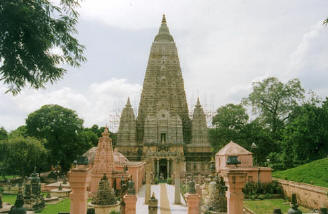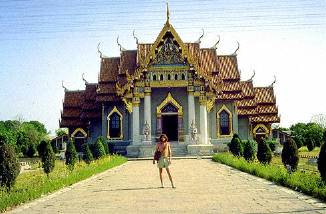- Mahabodhi Temple
The Mahabodhi Temble is located at the place of Lord Buddha's enlightenment. The temple has a 50m (170 ft) tower. The present temple was restored around 1880. There have been several other temples on this site. A previous temple was destroyed by the Muslims in the 11th century. Parts of the intricately carved railings to the south and west of the temple are very old. Some of the railings are original and parts of the railings are reproductions.
In the inner sanctuary there is a huge Buddha. In the center of the temple there is also a Siva-linga that was installed about 860. This temple is also sacred to the Hindus because Lord Buddha is the ninth incarnation of Lord Vishnu. - Bodhi Tree
The Bodhi tree here is said to be a descendent of the tree under which Budhha attained enlightenment. A sapling of the original bodhi tree that the Buddha sat under was carried by Emperor Ashoka's daughter (Sanghamitta) to Sri Lanka. That tree is at Anuradhapura in Sri Lanka. A cutting from that tree was planted in Budha Gaya when the original tree died. Under the tree is a red sandstone slab that is said to be the Vajrasana, the diamond throne, that Buddha sat on and attained nirvana. The tree is located behind the temple and is about 80 feet high and about 115 years old. - Vajrasana
Vajrasana, the seat of stability. Buddha supposed to have say in meditation gazing east, under the Bodhi Tree, where the Vajrasana, the stone platform is kept. - Chankaramana
This marks the sacred spot of the Buddha's meditative perambulations during the third week after pious enlightenment. It is believed that wherever the Buddha put his feet lotus sprang up. - Arimeshlochana
It is believed that the Buddha spent one week here looking towards the great Mahabodhi Tree out of gratitude, without twinkling his eyes. - Ratnagar
The Buddha spent one week here, where it is believed that five colours came out of his body.
Holy Destinations of India
Bodh Gaya
This is where Prince
Gautama attained enlightenment under the sacred Asvatta tree (Bodhi tree)
and became known as Lord Budha. This is one of the four most sacred
pilgrimage places for the Buddhists. The other three important places are
his place of birth at Lumbini, Nepal; the site of his first lecture at
Sarnath, near Varanasi; and the place where he left his body at Kushinagar,
near Gorakhpur. Buddhists from all over the world have built temples here in
Bodh Gaya. The Dalai Lama often spends time here. Tibetan pilgrims come here
for the winter from Dharamshala. Bodh Gaya is located about 13 km from Gaya,
450 km west of Calcutta, and 90 km south of Patna.
Bodh Gaya is a place which should be visited or seen by a person of devotion
and which would cause awareness of the nature of impermanence.
Siddhartha Gautama, the Buddha-to-be, had been dwelling on the banks of the
Nairanjana River with five ascetic followers for six years practicing
austerities. Realising that austerities could not lead to realisation he
abandoned them. His five ascetic companions disgusted at his seeming
failure, deserted him and left for Sarnath.
City Famous For
Performing Hindu Rituals
In fact, devout Hindus have an obligation to visit Gaya after the death of
their parents for certain rites, for Pindan, that ensures spiritual peace
and solace of the departed souls.It is incumbent upon every pilgrim, to
invoke the gods as witness, so that by completing the prescribed rites of
prayers for the peace and happiness he has freed himself from the debt he
owes to his dead ancestors. The ceremony can be performed almost anytime of
the year but people prefer to do so during the annual fair held in
September. Legend holds that Lord Buddha, when prince, performed the first
Pindan here.
Location
Gaya is located at a distance of 105 km from Patna in the state of Bihar.
Buddha Gaya is located 7 miles south of Gaya and is one of the well visited
Buddhist pilgrimage centers of the Indian subcontinent.
History
The history of Bodhgaya can be traced back to the 7th century and it was the part of the first small kingdoms of India. This place came to prominence when a prince called Siddhartha gave up all the material pleasures and after strenuous efforts through meditation, attained enlightenment or Nirvana under a Bodhi tree. There is also a small shrine that was built under the rule of the great Mauryan ruler Ashoka in the 3rd century B.C. It is one of the most important places in Bodhgaya and should not be missed out during your trip to Bodhgaya.
General Information :-
| Population | : | 25,585 |
| Languages | : | Bhojpuri, Hindi and English |
| Best time to visit | : | Winters |
| STD Code | : | 0631 |
Attractions of Bodh Gaya
|
|
The Mohanta's Monastery, located right next to the Mahabodhi Temple, is a Shaivite monastery. It is said that Adi Sankaracharya spent days here in a heated debate with buddhist philosophers.
At the Tibetan Mahayana Monastery (1938) there is a large Dharma Chakra, or wheel of law. It is believed that you will be freed of sin if you spin this wheel three times in succession from left to right. It is a 10m high metal drum painted gold and red.
Budha bathed in the nearby Niranjana (now called Lilanja) River after attaining enlightenment. The Niranjana River is about 250m east of the temple. Prince Siddharta crossed this river to reach the Bodhi tree.
Buddha Jayanti Festival
The Budha Jayanti festival in May, celebrates the appearance day of Buddha, the day he got enlightenment, and the day he left his body. It is the biggest festival day here.
Bodhgaya Revitalised
Since 1953, Bodh Gaya has been developed as an international place of pilgrimage. Buddhists from Sri Lanka, Thailand, Burma, Tibet, Bhutan and Japan have established monasteries and temples within easy walking distance of the Mahabodhi compound. The site of the enlightenment now attracts Buddhists and tourists from all over the world. At any time during the cooler months between December and March, a visitor to Bodh Gaya can observe a continual stream of Indian and international pilgrims walking the roads or arriving in buses, circumambulating the temple, performing prostrations and offering prayers in a multitude of languages. For those who aspire to awaken their full potential, Bodh Gaya today is truly a field vibrant with the potentiality of enlightenment. Enriched by devotion of Buddhists of all traditions, this holy site is emerging as a powerful inspiration to the modern world, awakening people of all nations to the real possibility of enlightenment.
Photos of Bodh Gaya
 |
 |
| Bodh Gaya Temple | Thai Temple at Bodh Gaya |
How to Reach
Bodh Gaya
:
Air : Although
Bodhgaya has no airport of its own, there is an airport in Gaya, which is 17
kms away from Bodhgaya.Most airlines from the important cities of India
touch Patna, which is 135 kms from Bodhgaya.
Rail : The nearest railway station is also Gaya.Trains from all major
cities of India stop at Gaya.Indian Railways has introduced a new train,
Buddha Parikrama that caters to Buddhist spiritual tour by linking all the
places associated with Buddha and Buddhism.
Road : Bodhgaya is the main bus stop and is located near Sujata
Bridge on the Falgu River on the northeastern edge of the town. The nearest
transport hub is Gaya, a major point on historical Grand Trunk Road There
are regular direct bus services from Gaya, Patna, Nalanda, Rajgir, Varanasi.
Bihar State Tourism Development Corporation run buses from Patna- Bodhgaya
route twice a day.
Accommodation in Bodh Gaya
All the hotels in Bodhgaya are located near the major landmarks of the town and can be accessed easily. The rooms are elegantly done up and are quite cozy giving you optimum level of comfort.
You can also accomplish the
business and recreational needs here since the hotels also extend the
facility of business and conferencing and arranges for the sightseeing tours
to the various important destinations that are located in the vicinity of
the city. The services provided by the various hotels are customized
according to the individual tastes and preferences of the discerning guests
and make them feel at home.
Among the various Bodhgaya Hotels, you can also accommodate your self in the
budget hotels in Bodhgaya that are just right for the travelers who are
traveling on a shoe-string budget. A comprehensive range of facilities and
services are provided to the guests at a reasonable